Cichlids are bright tropical fish that make striking showcases in aquariums and tanks for hobbyists and aquarists. Their unique coloring, large variety of breeds, and feisty nature are all winning characteristics of these freshwater fish. But what are the pros and cons of choosing South American cichlids or African cichlids? Which is better?
This handy guide will share all the best and most helpful information about South American and African cichlids so you can choose for yourself.
Table of Contents
What Are South American and African Cichlids?
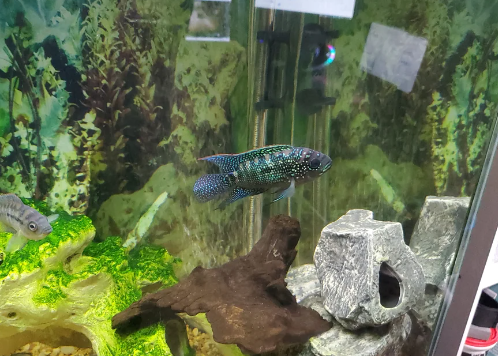
Cichlids are a fish family with more than 2,000 distinct breeds currently classified. New cichlid species are constantly being discovered in the native waters of the Great Lakes in Africa and South America’s waterways.
The theory is that cichlids were initially found on the supercontinent of Gondwana, which broke into our more familiar continents. The cichlids diversified and changed based on the conditions of the new continents. Today, you’ll find cichlids in South and Central America, India, Madagascar, and other African countries.
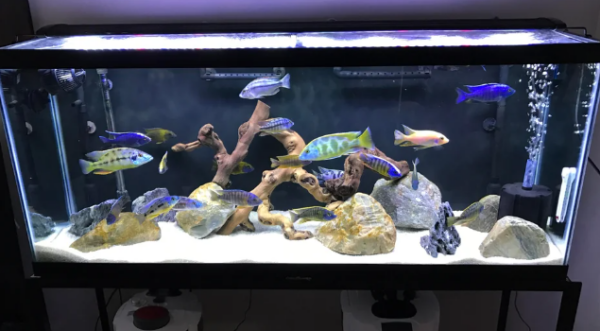
The cichlid family of fish has a vast diversity, and you will never tire of looking at their bright colors, unique markings, and distinctive shapes. Cichlids come in a range of shapes, sizes, and patterns. The species also range in temperament from passive, happy-community tank dwellers to more aggressive and territorial species that require special planning when keeping.
No two species of cichlids are identical, which makes choosing the cichlid species that’s right for your home aquarium quite a challenge.
Which Should You Choose Between South American and African Cichlids: The Pros and Cons
Knowing which cichlid species is best for your tank is often a choice between the South American cichlid and the African cichlid (the two dominant cichlid species lines).
To make the best and most informed decision, we have the pros and cons of both sides of the cichlid family tree.
South American Cichlids Pros
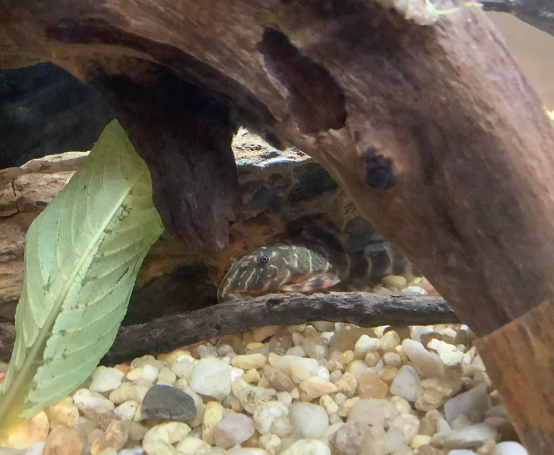
You’ll find the South American cichlids in the warm, soft waters of the Amazon River. There are many different varieties of South American cichlids, including the angelfish, discus, and firemouth cichlids, and each offers stunning coloring, unique features, and a vibrant presence in your aquarium.
Let’s look at the South American cichlid’s real pros:
- Diverse Sizes
South American cichlids are available in various sizes, including large and dwarf fish, making them appealing to different hobbyists. With a smaller size, it is easier to transport the fish, they are often more affordable, and you can safely accommodate more than one breeding pair in a medium-sized tank.
The different types of South American cichlids range in size from 24 inches to only an inch in length. With such a variety of sizes, you’re sure to find a cichlid that will fit your tank size.
- Unique Colors
With the many different colors and patterns of your South American cichlids, you will never have a boring aquarium.
There are over 300 classified South American cichlid types to enjoy a massive spectrum of hues, tones, and combinations.
- Great Temperament
Most South American cichlids are naturally peaceful, though territorial behavior may crop up when kept in limited space. The larger cichlids may also become aggressive as they are often carnivorous. Smaller cichlids may follow an omnivorous diet, so they munch on plants instead of other fish in your tank.
If you have a more aggressive cichlid species, choosing other cichlids as their tank mates is best. Most cichlids can become aggressive, and having more peaceful species in your tank helps limit bullying.
- Lifespan
When you have spent quite a bit on developing a cichlid tank, it’s a pleasure to learn that they have an extensive lifespan, with many easily living for 20 years in captivity. So, keeping South American cichlids is a life-long hobby.
- Entertainment Value
South American cichlids are great at entertaining. They have unique rituals and displays when it’s breeding season, and you’re sure to enjoy watching the males court the females and prepare a breeding area. Even the process of caring for their young is fascinating.
The adults are very involved in hatching their eggs, and the female will carry the fertilized eggs in her mouth until they are ready to hatch. The parents will also guard over their young once hatched, helping them survive those first few weeks when they are most at risk of being eaten by other fish.
- Unique and Interesting Facts
Your South American cichlids are truly interesting. Some can change color, while others can even change their sex (when certain conditions are met). The entire cichlid family tree hasn’t been mapped yet, and researchers are constantly discovering new species.
And if you want to add even more variety to your tank, add some dwarf cichlids, which are softer in shape and almost squishy.
African Cichlids Pros
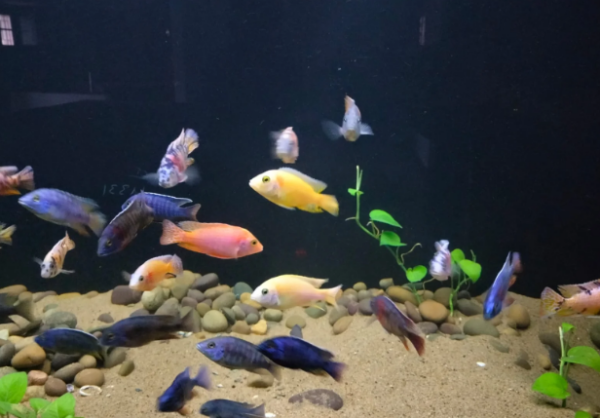
If you want an even brighter pop of color in your tank, the African cichlid should be your first stop. These colorful, diverse, and unique cichlids are native to three African great lakes. You will find them in the wilds of Lake Victoria, Lake Malawi, and Lake Tanganyika.
However, you don’t have to go on an African safari to catch some of these magnificent fish. They are also wild-bred, and many of the more popular types of African cichlids are available from quality aquatic dealers.
Let’s look at some of their pros:
- More Hardy
African cichlids are more hardy than their South American cousins. They are known to be more resilient and can tolerate a broader range of water parameters. If you are a newbie at tropical fish management, then opting for an African cichlid is an excellent choice.
- Omnivorous Fish
Since African cichlids are omnivorous, they will eat anything, making them good casual feeders. If the other tank mates only eat live feed, you don’t have to worry, as they will also happily gobble up the shrimps and other live treats. They will also thrive on fresh veggies and plant-based feed.
- Larger in Size
Because African cichlids are generally bigger than South American cichlids, they make a stunning display in a large tank. If you want to keep a medium tank with an attractive cichlid or two, there are African cichlids that are medium-sized and ideal.
However, ensure you choose a suitable variety of African cichlids as some of these cichlids can reach a size of 36 inches, meaning that you may need a bigger tank. Most African cichlid varieties reach a fairly big size, and with their territorial nature, you’d have to ensure they have enough room to avoid bullying.
- Hard Water Tolerant
Aquarists know that one of the main issues with tropical fish is their tolerance to water hardness. Since African cichlids are adapted to the mineral-rich water of the Great Lakes in Africa, they are more resilient to hard water.
Many states in the U.S. are known for mineral deposits in their water supply, making it challenging to use tap water to refill your aquarium or do water changes. Luckily, with African cichlids, you have a much wider range of water hardness parameters to use.
- They Do Well in Small Groups
African cichlids don’t always mix well, but as long as you add them to the tank at the same time, they can learn to co-exist peacefully with other cichlid species or much larger fish. Cichlids are known to be territorial, so prevent aggression by maintaining a healthy ratio of 1 male to 3 females in smaller tanks.
South American Cichlids Cons
Of course, no two fish species are equally ideal for your tank, and each has their cons, too. The South American cichlid has a few points that may influence your decision to get them or not.
Here are a few cons that affect the South American cichlid:
- Less Adaptable to Water Parameters
Because the South American cichlids are used to softer water in the Amazonian basin, they don’t adapt as well when regular tap water is used in their tanks. Even if you remove the usual chemicals like chlorine, the water may still not be soft enough. This can mean the costly expense of using water filtered with reverse osmosis, creating a more neutral water type that’s better for these fish.
- Not as Hardy
South American cichlids aren’t as hardy as their African cichlid cousins. They may be more prone to diseases that affect tropical fish.
Ich, fungal infections, and bacterial infections are common among South American cichlids as they are much more sensitive to changes in their water parameters. Hole-in-the-head disease and bloat are also often a problem if their living conditions aren’t ideal.
- Can Become Aggressive
With their slightly more volatile nature, South American cichlids can be aggressive and territorial in a community tank. While they’re not as aggressive as African cichlids, you should take care with South American cichlids to keep them in the right school sizes and match them with less aggressive, hardy fish to minimize bullying.
African Cichlids Cons
African cichlids may be hardy, resilient, and more adaptable to changes in their water conditions, but they also have a few cons that affect them. Consider these cons:
- Aggression
Since African cichlids are quite territorial (more so than the South American cichlids), it’s often better to keep them isolated in small groups, as they can quickly begin to bully other fish in community tanks.
- Size Factor
While it’s always nice to see your fish grow big and strong, the overall size potential of some African cichlids may mean they can outgrow your tank, causing you to have to upscale. This can be an unanticipated cost.
- Tropical Fish Diseases
African cichlids are more hardy than South American cichlids, but they still suffer from typical tropical fish diseases like ich, fungal and bacterial infections, and bloat. Feed appropriately, stock their tank with aquatic plants so that they won’t gobble up, and maintain the best water parameters to prevent disease.
- Aquascaping Damage
When you’ve paid a hefty sum for rare aquatic plants, seeing your new African cichlid uproot plants and damaged roots is devastating. Sadly, African cichlids can be destructive to aquatic plants. You must ensure the roots are well-secured when keeping them in a planted aquarium.
Discover the most detailed information about the Texas cichlid, the only cichlid native to North America.
Best Cichlid for Large Tanks
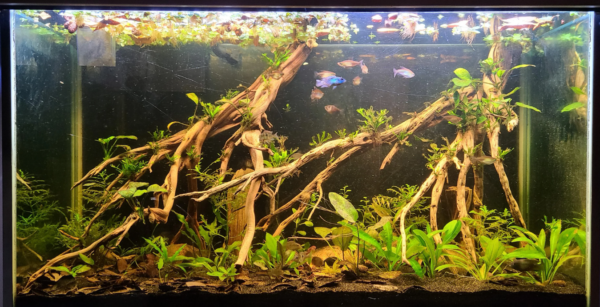
Cichlids can work well in most tanks if you choose a variety that won’t outgrow the tank. More space is always better, but African cichlids are a great choice if you have a huge tank and don’t want to keep multiple schools of cichlids.
Choose from varieties like the lionhead cichlid, bumblebee cichlid, and the popular electric yellow cichlid for your large tank. Remember that each cichlid requires enough space, and in a 40-gallon tank, you should have no more than 1 to 2 males and 3 to 4 females.
Best Cichlid for Small Tanks
You can keep certain African cichlid varieties in smaller tanks, but South American cichlids would be a better bet for a smaller tank space. As a rule, it’s 30 gallons for the first cichlid, with an additional three gallons per extra cichlid.
Remember to calculate your tank space based on the adult size the cichlids may reach.
Best Cichlid for Hard Water
African cichlids are used to the mineral-rich water of the Great Lakes in Africa. Some aquarists believe in adding Malawi salt (Cichlid Lake Salt or Malawi/Victoria Buffer) to simulate their natural water parameters better. If you live in a state with hard water, keeping African cichlids over South American cichlids is a safer bet.
If the water pH and temperature are optimal and harmful chemicals like chlorine have been removed, your African cichlid should survive in tap water.
Best Cichlid for Soft Water
The Amazon is known for the soft water created by the ecosystem’s decaying vegetation and unique minerals. If you live in an area with soft water, you can likely keep South American cichlids, but some varieties of African cichlids will also adapt.
Best Cichlid for Planted Aquarium
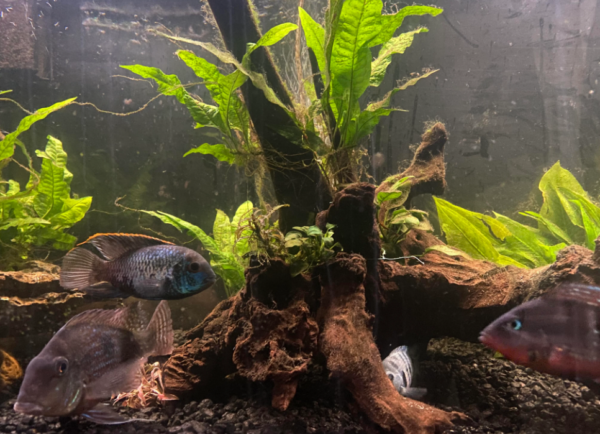
If you have a planted aquarium, South American cichlids are better suited. While they may forage extensively on plants, they are less likely to uproot plants than African cichlids.
Adding a few African cichlids is a better choice for a stone or gravel aquarium.
Discover how to keep your aquarium fish from becoming ill in our tips guide.
FAQs
Cichlids are constantly being studied, with new varieties frequently identified. They are one of the largest vertebrate fish families and have many different subspecies with unique coloring and features.
Distinct cichlid species are found in the wild on two separate continents, which is also unusual.
Determine whether a fish is a cichlid with the following characteristics:
– They have one nostril.
– They have three or more anal spines.
– They can reach a substantial size.
– They have rounded tail fins.
The answer will depend on which variety of cichlids you’d like to add to your community tank. Some small or dwarf South American cichlids make excellent additions to community tanks. However, the aggression level depends on each variant’s nature, so do your homework on each species before you choose.
Final Cichlid Thoughts
Cichlids are hugely popular tropical freshwater fish. They are ideal for aquariums that have been carefully prepared for them. Choose between the South American vs African cichlids by considering the pros and cons of each species and variants.
For a cichlid-only tank, adding the African cichlid works well, and you’ll have more room for water tolerances if you live in a hard water area. However, if you want to add a few cichlids to a community tank, the friendlier and smaller South American variants are better options.
As always, you should research the type of cichlid you’d like to add to your aquarium before purchasing so you can perfectly match their pH, temperature, and water hardness requirements with the other community fish.
Enjoy your vibrant and colorful cichlid tank! Learn about the benefits of live aquarium plants in our handy guide.
No related posts.
